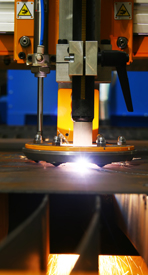Superior coatings through nanoscale surface engineering
The growing complexity and sophistication of systems engineering used in many sectors, including aerospace and robotics has spurred on TRIBO project partners to adopt laser-assisted technologies in the manipulation of nanomaterials. Nanomaterials are known for their outstanding mechanical properties that may lead to enhanced wear resistance of friction joints working under severe conditions. More specifically, laser cladding can be performed to improve the surface properties of metallic machine elements locally. A cladding material with the desired properties is fused onto a substrate by means of a laser beam. The mixing between the two materials must be as small as possible to utilise the properties of the coating material most effectively. By improving a technical surface locally with dedicated nanomaterials, an ordinary cheap base material can be used for the surfaces that are not being exposed to high loads. Engineers at the École Nationale d'Ingénieurs de Saint-Étienne in France mixed various powder materials in a blend to achieve a composite coating with the desired properties. The rapid laser processing created an array of artificial holes serving as reservoirs for debris and solid lubricants, which would be gradually released into the contact area. The coatings developed with functionally graded material consisted of solid lubricants such as white bronze (CuSn) serving as a ductile matrix, which was however reinforced by the appropriate ceramic phase. The wear tests that were subsequently performed showed that the dry friction coefficient of these coatings may reach values as low as 0.12. Furthermore, the unique possibility of using high energy beams to rapidly melt and remix alloying elements was exploited to improve the wear resistance of bearing steels. The TRIBO project partners used shielding covers to avoid the evaporation of alloying elements from the surface of the base metal, in addition to combining the action of different types of lasers. For example, pulse-periodic and continuous wave lasers were tested on systems of base metal-alloying elements such as aluminium-tin (Al-Sn) and iron-tin (Fe-Sn). This gave rise to uniform distribution of alloying elements in the molten pool, while the fast cooling of the melt led to formation of Sn-rich precipitations, opening the way for industrial penetration of nanotechnologies. The average concentration of Sn, which can be used as a solid lubricant, was measured by X-ray microprobe analysis and was found to exceed 20wt.%.







